Features
THE LAST LAP: Zürich-München-Paris-London-Colombo
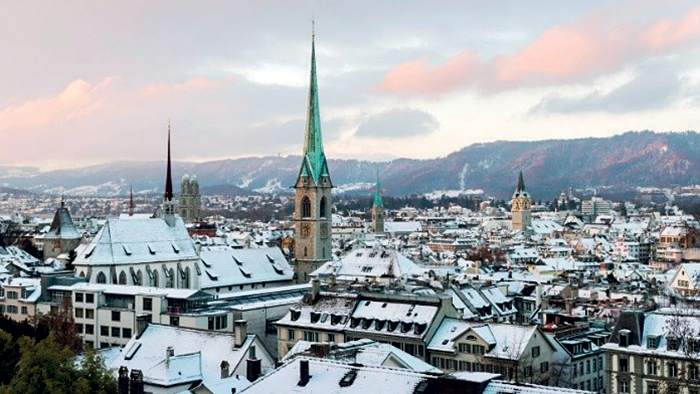
CONFESSIONS OF A GLOBAL GYPSY
By Dr. Chandana (Chandi) Jayawardena DPhil
President – Chandi J. Associates Inc. Consulting, Canada
Founder & Administrator – Global Hospitality Forum
chandij@sympatico.ca
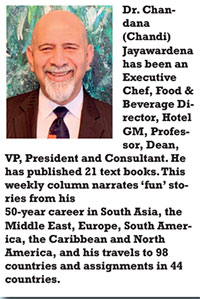
The last lap of our six-week-long adventure in the midst of a brutal winter included my solo brief visits to a few cities in Switzerland. We also visited one city in West Germany and visited the capital of France, before returning to the United Kingdom. Soon after ending the trip, I needed to focus on re-commencing my career in hospitality management. The last week of the trip went fast.
Brig
I left my friend’s house in Zug early in the morning to catch a train to the Swiss capital city, Bern. I did a brief walk around this city which I had visited three years prior. My train from Bern to Brig took a little over two hours. Dr. Wolfgang D. Petri, the president of Hotelconsult (now, César Ritz Colleges Switzerland) was at the Brig train station to welcome me.
In 1982, he opened the first hotel school in Brig as part of the Hotelconsult Management Company. Soon afterwards, I secured a contract for our family business – Streamline Services, as their student recruitment agency in Sri Lanka. The school expanded rapidly. I was invited to spend a couple of days with Hotelconsult. “Welcome to Brig! Thank you very much for recruiting Sri Lankan students who are doing well here,” Dr. Petri said.
After a quick tour of their main campus in Brig, he hosted me, six of the Lankan students there and four of their Swiss lecturers to lunch at the training restaurant. They maintained very high standards. After lunch I attended a faculty meeting. Then he took me on a 30-minute drive to their new, second campus in a nearby village – Lax. This is the most beautiful location of a hotel school I have ever seen.
Since the opening of the oldest and the best-known hotel school in the world – École Hôtelière de Lausanne (EHL) in 1893, Switzerland created a reputation as the Mecca of hospitality management education in the world. In the early 1980s, a few Swiss hotel schools commenced programs in English to appeal to a wider canvas. Dr. Petri was one of those leaders who created a new, international vision for the Swiss hospitality management education.
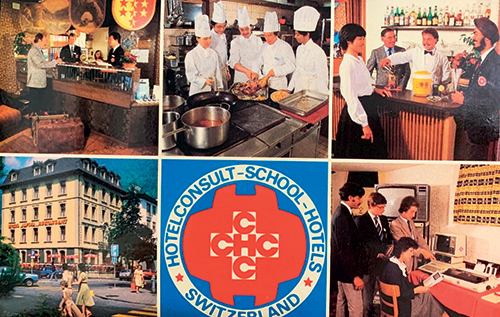
During the return drive from Lax to Brig, Dr. Petri briefed me about their plans to launch Switzerland’s first Bachelor of Arts program in Hotel Management in partnership with Washington State University in USA in 1985. I was very impressed with Dr. Petri’s vision, his focus on student success, his ambition for the school and his passion for excellence. He was an inspiration to me. The seed he planted in my mind that day resulted in creating the first international hotel school in Sri Lanka, with myself as the founding Managing Director in 1991.
Next morning, I was invited to deliver a guest lecture, which was popular with the students. Six years later, I realized that my 1985 guest lecture in Switzerland was also popular with the Swiss lecturers at Hotelconsult. One of them, Heinz Buerki, left Hotelconsult to set up a competitor hotels school – IMI International Management Institute near Lucerne, Switzerland, in 1991. Soon after that, he contacted me and appointed me a Visiting Professor of IMI. I did two teaching contracts in Switzerland in 1992 and 1993. IMI also appointed our family business – Streamline Services — as the exclusive student recruiting agency for IMI in Sri Lanka.
When I look back, I realize that I have been fortunate to get such opportunities around the world to open doors for further progress. In 2013, as the Associate Dean of the largest faculty for Hospitality Management and Culinary Arts in Canada, I signed an education pathway agreement between my employer, George Brown College and IMI. When Heinz Buerki met me in Toronto for that, he fondly remembered our long-established professional relationship since 1985.
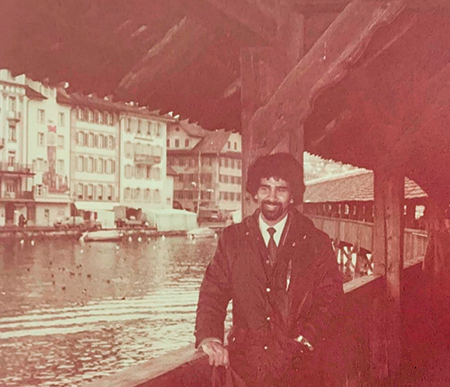
I am not surprised that as of 2022, César Ritz Colleges Switzerland is ranked sixth in the world (just behind Lausanne, UNLV, SHMS, Glion and Les Roches) among the best hospitality and leisure schools, according to the QS World University Rankings. I am happy that I was able to make a small contribution to their success for a few years from their inception, 40 years ago.After two days in Brig, I took an early morning train to Lausanne with a short sight-seeing stop in a small town of 750 residents – Fiesch. I had breakfast there and reached Lausanne for lunch and a city tour. After that I took a three-hour train ride to Luzern, In time for a late dinner and overnight stay.
Next morning, I explored Luzern, a city which I visited several times in later years, during my teaching stints at IMI in the early 1990s in a nearby village – Weggis, in the canton of Lucerne. My first visit to Luzern was memorable. For fun, I crossed the river four times using the famous bridges of Luzern, including the Kapellbrücke (or the Chapel Bridge) a beautiful, covered, wooden footbridge spanning the river Reuss diagonally.
Next day I travelled to München in West Germany with an interesting stop in the largest city in Switzerland. Although my stop in Zürich was short, I was happy to visit the capital of the canton of Zürich, for the first time. Zürich is a hub for railways, roads, and air traffic. Both Zurich Airport and Zürich’s main railway station are the largest and busiest in the country. It was a cold day with snow and rain, but I did a walk around in the heart of the city to get a quick impression.
When I arrived in München in the evening, I was given a warm welcome by my wife, her mother and our West German family friends, Angelika and Gerhard. They insisted that we have a formal dinner in their house. It had been three years since we met them in München and five years since they last visited us in Sri Lanka when they did a special trip to attend our wedding in 1980. It was very nice catching up. Angelika worked as a flight attendant for Lufthansa Airline and Gerhard had a busy practice as a corporate lawyer.
As we visited most of the key attractions of München during the last visit, our hosts took us to an attraction we had missed the previous time – the Deutsches Museum, that had been established in 1903. We loved the main site of the Museum, which was on a small island in the Isar river. It had been used for rafting wood since the Middle Ages. This is the world’s largest museum of science and technology, with over 25,000 exhibited objects from 50 fields of science and technology. It receives nearly 1.5 million visitors per year. For a period of time the museum was also used as a venue to host pop and rock concerts.
We left München around 7:00 am and the train took 10 hours to reach our last key destination – Paris. We found an inexpensive, old hotel near the Gare de l’Est, one of the six large, mainline railway station terminals in Paris. We were happy with the room rate of FF150, but then they charged another FF70 for us to use the bathroom facilities!
As it was our fifth visit to Paris, we had previously seen most of the key tourist attractions there. After one of the most brutal, winter storms, the weather in France had improved and the snow had melted. We took the metro to the city centre and visited Palais Garnier, built in 1875 for the Paris Opera. We then walked along the beautifully illuminated Rue de la Paris – a fashionable shopping street in the centre of Paris and Boulevard des Capucines. As it was my mother-in-law’s first visit to Paris, the next day we did a three-hour city tour and re-visited the Eiffel Tower and Arc de Triomphe.
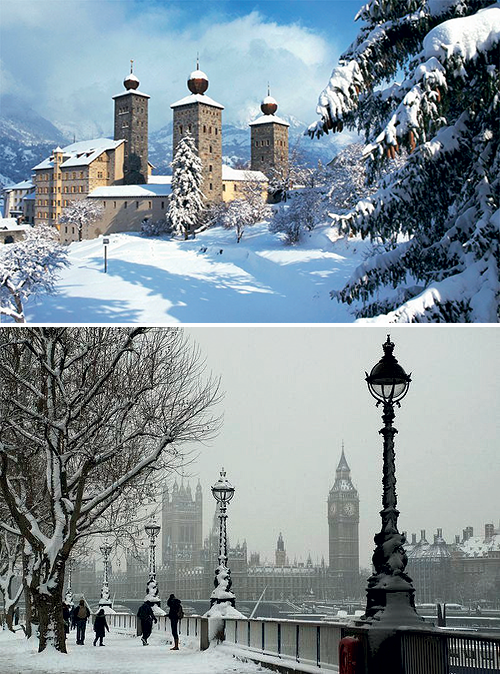
There is no better place than Paris to end a memorable, lengthy trip of Europe. Three years after that, in 1988, my employer then – Le Meridien hotel company owned by Air France, sent me for advanced, management training in Paris and Tours. I love visiting Paris.
After two days In Paris, we took a night coach around 9:00 pm. We arrived in Amiens around 1:00 am and then reached Boulogne-Sur-Mer around 3:00 am, to catch our ferry to Dover. In the ferry we analysed our last six weeks of travelling to 17 European countries. During that short period of time, my wife had visited 34 cities and I had visited 45 cities. To do that we travelled around 300 hours in trains, ferries and coaches. We were a little over budget and had spent a total of £1,500 including the cost of food. Still, it was a shoe-string budget, money well spent.
We concluded that the most pleasant surprises during the trip were Oporto and Budapest, and the most beautiful cities we ever visited were Venice and Paris. Around seven in the morning, we reached our favourite city in the world – London.
London was cold, rainy and snowy, but we were happy to be back. My wife went to work on the same day, and I had scheduled a few job interviews the very next day. The uncertainty of what the future held for us added to the sense of adventure during our long trip.Now it was the decision time, for a stable future. Having gained a long list of academic and professional qualifications and a wide range of experiences in most of the five-star hotels in the United Kingdom since 1983, I was optimistic.
We were prepared to go anywhere in the world, if I could secure a good job fulfilling my next two career goals. I was targeting to become the Food & Beverage Manager of a large, five-star international hotel by age 31. Then, after a few years, become the General Manager of such a hotel by age 34.
However, I was not successful in finding a suitable management position in any British company. I felt that earning the first ever MSc in International Hotel Management went against my suitability for certain jobs. The Vice Presidents who interviewed me in London, felt that I was over-qualified! In a hands-on industry, such as hoteliering, companies were not used to managers with master’s degrees. That was then, but 37 years later, today, having a master’s degree is fast becoming a prerequisite for an international hotel manager.
One Director of the Trust House Forte head office in London who interviewed me for the post of Food & Beverage Manager of their five-star hotel in Amman, Jordan, gave me a very practical suggestion. He said, “Why don’t you go back to Sri Lanka and attempt to join a five-star, international hotel there? After a couple of years’ management experience in a five-star hotel there, you should be able to launch your international hotel management career.”
I was disappointed when I was not hired for the job, but I took his advice seriously. Within a week, we packed our bags and left England to re-settle in Sri Lanka in search of a suitable opportunity to earn my Return on Investment (ROI) in Continuous Professional Development (CPD).
Colombo
Early morning
All are still sleeping
The house in total silence
The gate creaks as I leave home
To explore a city, I missed dearly
Good morning, sir, greets the neighbourhood thug
I commence a long nostalgic walk
Towards my alma mater
A Buddhist sermon in Pali on a radio played loudly
A Hindu mantra from a worshipper outside a kovil
An Arabic prayer from a nearby mosque
While a bell rings at an adjoining church
Gradually, the road gets louder
With sounds of crows, stray dogs, and tuk tuks
A bus conductor announcing next stops
Horns of cars stuck in a crazy traffic jam
A policeman loudly blows his whistle
School girls giggle near a crowded bus stand
A woman sweeping pavements while chatting
A devotee uttering gathas while worshipping a Bo tree
A beggar begging for a coin or two
A sweep ticket seller screaming for last day sales
A mother talks to a child in Sinhala
A boy yells at a buddy in Tamil
Two executives talk in English
A vendor speaks broken English trying to close a sale
All blend fleetingly like a symphony
But, unconducted
The scent of tea when passing an eating house
The aroma of sambar gravy when passing a thosai spot
The smell of freshly baked bread when passing a bakery
The perfume of joss sticks when passing a temple
The fragrance of flowers when passing a flower shop
Bring back memories from my good old school days
All seems to blend well in a city
Now more diverse than ever before
Giving a true cosmopolitan feel
Still a poor city with plenty security barriers
To protect from periodical terrorist attacks
Now back in my home town for good or bad
Nice to travel the world
Yet, there is no better place
Other than my birth place
Always there waiting patiently
Like a loving mother
To welcome me back
I simply love
My Colombo …
Features
The heart-friendly health minister

by Dr Gotabhya Ranasinghe
Senior Consultant Cardiologist
National Hospital Sri Lanka
When we sought a meeting with Hon Dr. Ramesh Pathirana, Minister of Health, he graciously cleared his busy schedule to accommodate us. Renowned for his attentive listening and deep understanding, Minister Pathirana is dedicated to advancing the health sector. His openness and transparency exemplify the qualities of an exemplary politician and minister.
Dr. Palitha Mahipala, the current Health Secretary, demonstrates both commendable enthusiasm and unwavering support. This combination of attributes makes him a highly compatible colleague for the esteemed Minister of Health.
Our discussion centered on a project that has been in the works for the past 30 years, one that no other minister had managed to advance.
Minister Pathirana, however, recognized the project’s significance and its potential to revolutionize care for heart patients.
The project involves the construction of a state-of-the-art facility at the premises of the National Hospital Colombo. The project’s location within the premises of the National Hospital underscores its importance and relevance to the healthcare infrastructure of the nation.
This facility will include a cardiology building and a tertiary care center, equipped with the latest technology to handle and treat all types of heart-related conditions and surgeries.
Securing funding was a major milestone for this initiative. Minister Pathirana successfully obtained approval for a $40 billion loan from the Asian Development Bank. With the funding in place, the foundation stone is scheduled to be laid in September this year, and construction will begin in January 2025.
This project guarantees a consistent and uninterrupted supply of stents and related medications for heart patients. As a result, patients will have timely access to essential medical supplies during their treatment and recovery. By securing these critical resources, the project aims to enhance patient outcomes, minimize treatment delays, and maintain the highest standards of cardiac care.
Upon its fruition, this monumental building will serve as a beacon of hope and healing, symbolizing the unwavering dedication to improving patient outcomes and fostering a healthier society.We anticipate a future marked by significant progress and positive outcomes in Sri Lanka’s cardiovascular treatment landscape within the foreseeable timeframe.
Features
A LOVING TRIBUTE TO JESUIT FR. ALOYSIUS PIERIS ON HIS 90th BIRTHDAY

by Fr. Emmanuel Fernando, OMI
Jesuit Fr. Aloysius Pieris (affectionately called Fr. Aloy) celebrated his 90th birthday on April 9, 2024 and I, as the editor of our Oblate Journal, THE MISSIONARY OBLATE had gone to press by that time. Immediately I decided to publish an article, appreciating the untiring selfless services he continues to offer for inter-Faith dialogue, the renewal of the Catholic Church, his concern for the poor and the suffering Sri Lankan masses and to me, the present writer.
It was in 1988, when I was appointed Director of the Oblate Scholastics at Ampitiya by the then Oblate Provincial Fr. Anselm Silva, that I came to know Fr. Aloy more closely. Knowing well his expertise in matters spiritual, theological, Indological and pastoral, and with the collaborative spirit of my companion-formators, our Oblate Scholastics were sent to Tulana, the Research and Encounter Centre, Kelaniya, of which he is the Founder-Director, for ‘exposure-programmes’ on matters spiritual, biblical, theological and pastoral. Some of these dimensions according to my view and that of my companion-formators, were not available at the National Seminary, Ampitiya.
Ever since that time, our Oblate formators/ accompaniers at the Oblate Scholasticate, Ampitiya , have continued to send our Oblate Scholastics to Tulana Centre for deepening their insights and convictions regarding matters needed to serve the people in today’s context. Fr. Aloy also had tried very enthusiastically with the Oblate team headed by Frs. Oswald Firth and Clement Waidyasekara to begin a Theologate, directed by the Religious Congregations in Sri Lanka, for the contextual formation/ accompaniment of their members. It should very well be a desired goal of the Leaders / Provincials of the Religious Congregations.
Besides being a formator/accompanier at the Oblate Scholasticate, I was entrusted also with the task of editing and publishing our Oblate journal, ‘The Missionary Oblate’. To maintain the quality of the journal I continue to depend on Fr. Aloy for his thought-provoking and stimulating articles on Biblical Spirituality, Biblical Theology and Ecclesiology. I am very grateful to him for his generous assistance. Of late, his writings on renewal of the Church, initiated by Pope St. John XX111 and continued by Pope Francis through the Synodal path, published in our Oblate journal, enable our readers to focus their attention also on the needed renewal in the Catholic Church in Sri Lanka. Fr. Aloy appreciated very much the Synodal path adopted by the Jesuit Pope Francis for the renewal of the Church, rooted very much on prayerful discernment. In my Religious and presbyteral life, Fr.Aloy continues to be my spiritual animator / guide and ongoing formator / acccompanier.
Fr. Aloysius Pieris, BA Hons (Lond), LPh (SHC, India), STL (PFT, Naples), PhD (SLU/VC), ThD (Tilburg), D.Ltt (KU), has been one of the eminent Asian theologians well recognized internationally and one who has lectured and held visiting chairs in many universities both in the West and in the East. Many members of Religious Congregations from Asian countries have benefited from his lectures and guidance in the East Asian Pastoral Institute (EAPI) in Manila, Philippines. He had been a Theologian consulted by the Federation of Asian Bishops’ Conferences for many years. During his professorship at the Gregorian University in Rome, he was called to be a member of a special group of advisers on other religions consulted by Pope Paul VI.
Fr. Aloy is the author of more than 30 books and well over 500 Research Papers. Some of his books and articles have been translated and published in several countries. Among those books, one can find the following: 1) The Genesis of an Asian Theology of Liberation (An Autobiographical Excursus on the Art of Theologising in Asia, 2) An Asian Theology of Liberation, 3) Providential Timeliness of Vatican 11 (a long-overdue halt to a scandalous millennium, 4) Give Vatican 11 a chance, 5) Leadership in the Church, 6) Relishing our faith in working for justice (Themes for study and discussion), 7) A Message meant mainly, not exclusively for Jesuits (Background information necessary for helping Francis renew the Church), 8) Lent in Lanka (Reflections and Resolutions, 9) Love meets wisdom (A Christian Experience of Buddhism, 10) Fire and Water 11) God’s Reign for God’s poor, 12) Our Unhiddden Agenda (How we Jesuits work, pray and form our men). He is also the Editor of two journals, Vagdevi, Journal of Religious Reflection and Dialogue, New Series.
Fr. Aloy has a BA in Pali and Sanskrit from the University of London and a Ph.D in Buddhist Philosophy from the University of Sri Lankan, Vidyodaya Campus. On Nov. 23, 2019, he was awarded the prestigious honorary Doctorate of Literature (D.Litt) by the Chancellor of the University of Kelaniya, the Most Venerable Welamitiyawe Dharmakirthi Sri Kusala Dhamma Thera.
Fr. Aloy continues to be a promoter of Gospel values and virtues. Justice as a constitutive dimension of love and social concern for the downtrodden masses are very much noted in his life and work. He had very much appreciated the commitment of the late Fr. Joseph (Joe) Fernando, the National Director of the Social and Economic Centre (SEDEC) for the poor.
In Sri Lanka, a few religious Congregations – the Good Shepherd Sisters, the Christian Brothers, the Marist Brothers and the Oblates – have invited him to animate their members especially during their Provincial Congresses, Chapters and International Conferences. The mainline Christian Churches also have sought his advice and followed his seminars. I, for one, regret very much, that the Sri Lankan authorities of the Catholic Church –today’s Hierarchy—- have not sought Fr.
Aloy’s expertise for the renewal of the Catholic Church in Sri Lanka and thus have not benefited from the immense store of wisdom and insight that he can offer to our local Church while the Sri Lankan bishops who governed the Catholic church in the immediate aftermath of the Second Vatican Council (Edmund Fernando OMI, Anthony de Saram, Leo Nanayakkara OSB, Frank Marcus Fernando, Paul Perera,) visited him and consulted him on many matters. Among the Tamil Bishops, Bishop Rayappu Joseph was keeping close contact with him and Bishop J. Deogupillai hosted him and his team visiting him after the horrible Black July massacre of Tamils.
Features
A fairy tale, success or debacle

Sri Lanka-Singapore Free Trade Agreement
By Gomi Senadhira
senadhiragomi@gmail.com
“You might tell fairy tales, but the progress of a country cannot be achieved through such narratives. A country cannot be developed by making false promises. The country moved backward because of the electoral promises made by political parties throughout time. We have witnessed that the ultimate result of this is the country becoming bankrupt. Unfortunately, many segments of the population have not come to realize this yet.” – President Ranil Wickremesinghe, 2024 Budget speech
Any Sri Lankan would agree with the above words of President Wickremesinghe on the false promises our politicians and officials make and the fairy tales they narrate which bankrupted this country. So, to understand this, let’s look at one such fairy tale with lots of false promises; Ranil Wickremesinghe’s greatest achievement in the area of international trade and investment promotion during the Yahapalana period, Sri Lanka-Singapore Free Trade Agreement (SLSFTA).
It is appropriate and timely to do it now as Finance Minister Wickremesinghe has just presented to parliament a bill on the National Policy on Economic Transformation which includes the establishment of an Office for International Trade and the Sri Lanka Institute of Economics and International Trade.
Was SLSFTA a “Cleverly negotiated Free Trade Agreement” as stated by the (former) Minister of Development Strategies and International Trade Malik Samarawickrama during the Parliamentary Debate on the SLSFTA in July 2018, or a colossal blunder covered up with lies, false promises, and fairy tales? After SLSFTA was signed there were a number of fairy tales published on this agreement by the Ministry of Development Strategies and International, Institute of Policy Studies, and others.
However, for this article, I would like to limit my comments to the speech by Minister Samarawickrama during the Parliamentary Debate, and the two most important areas in the agreement which were covered up with lies, fairy tales, and false promises, namely: revenue loss for Sri Lanka and Investment from Singapore. On the other important area, “Waste products dumping” I do not want to comment here as I have written extensively on the issue.
1. The revenue loss
During the Parliamentary Debate in July 2018, Minister Samarawickrama stated “…. let me reiterate that this FTA with Singapore has been very cleverly negotiated by us…. The liberalisation programme under this FTA has been carefully designed to have the least impact on domestic industry and revenue collection. We have included all revenue sensitive items in the negative list of items which will not be subject to removal of tariff. Therefore, 97.8% revenue from Customs duty is protected. Our tariff liberalisation will take place over a period of 12-15 years! In fact, the revenue earned through tariffs on goods imported from Singapore last year was Rs. 35 billion.
The revenue loss for over the next 15 years due to the FTA is only Rs. 733 million– which when annualised, on average, is just Rs. 51 million. That is just 0.14% per year! So anyone who claims the Singapore FTA causes revenue loss to the Government cannot do basic arithmetic! Mr. Speaker, in conclusion, I call on my fellow members of this House – don’t mislead the public with baseless criticism that is not grounded in facts. Don’t look at petty politics and use these issues for your own political survival.”
I was surprised to read the minister’s speech because an article published in January 2018 in “The Straits Times“, based on information released by the Singaporean Negotiators stated, “…. With the FTA, tariff savings for Singapore exports are estimated to hit $10 million annually“.
As the annual tariff savings (that is the revenue loss for Sri Lanka) calculated by the Singaporean Negotiators, Singaporean $ 10 million (Sri Lankan rupees 1,200 million in 2018) was way above the rupees’ 733 million revenue loss for 15 years estimated by the Sri Lankan negotiators, it was clear to any observer that one of the parties to the agreement had not done the basic arithmetic!
Six years later, according to a report published by “The Morning” newspaper, speaking at the Committee on Public Finance (COPF) on 7th May 2024, Mr Samarawickrama’s chief trade negotiator K.J. Weerasinghehad had admitted “…. that forecasted revenue loss for the Government of Sri Lanka through the Singapore FTA is Rs. 450 million in 2023 and Rs. 1.3 billion in 2024.”
If these numbers are correct, as tariff liberalisation under the SLSFTA has just started, we will pass Rs 2 billion very soon. Then, the question is how Sri Lanka’s trade negotiators made such a colossal blunder. Didn’t they do their basic arithmetic? If they didn’t know how to do basic arithmetic they should have at least done their basic readings. For example, the headline of the article published in The Straits Times in January 2018 was “Singapore, Sri Lanka sign FTA, annual savings of $10m expected”.
Anyway, as Sri Lanka’s chief negotiator reiterated at the COPF meeting that “…. since 99% of the tariffs in Singapore have zero rates of duty, Sri Lanka has agreed on 80% tariff liberalisation over a period of 15 years while expecting Singapore investments to address the imbalance in trade,” let’s turn towards investment.
Investment from Singapore
In July 2018, speaking during the Parliamentary Debate on the FTA this is what Minister Malik Samarawickrama stated on investment from Singapore, “Already, thanks to this FTA, in just the past two-and-a-half months since the agreement came into effect we have received a proposal from Singapore for investment amounting to $ 14.8 billion in an oil refinery for export of petroleum products. In addition, we have proposals for a steel manufacturing plant for exports ($ 1 billion investment), flour milling plant ($ 50 million), sugar refinery ($ 200 million). This adds up to more than $ 16.05 billion in the pipeline on these projects alone.
And all of these projects will create thousands of more jobs for our people. In principle approval has already been granted by the BOI and the investors are awaiting the release of land the environmental approvals to commence the project.
I request the Opposition and those with vested interests to change their narrow-minded thinking and join us to develop our country. We must always look at what is best for the whole community, not just the few who may oppose. We owe it to our people to courageously take decisions that will change their lives for the better.”
According to the media report I quoted earlier, speaking at the Committee on Public Finance (COPF) Chief Negotiator Weerasinghe has admitted that Sri Lanka was not happy with overall Singapore investments that have come in the past few years in return for the trade liberalisation under the Singapore-Sri Lanka Free Trade Agreement. He has added that between 2021 and 2023 the total investment from Singapore had been around $162 million!
What happened to those projects worth $16 billion negotiated, thanks to the SLSFTA, in just the two-and-a-half months after the agreement came into effect and approved by the BOI? I do not know about the steel manufacturing plant for exports ($ 1 billion investment), flour milling plant ($ 50 million) and sugar refinery ($ 200 million).
However, story of the multibillion-dollar investment in the Petroleum Refinery unfolded in a manner that would qualify it as the best fairy tale with false promises presented by our politicians and the officials, prior to 2019 elections.
Though many Sri Lankans got to know, through the media which repeatedly highlighted a plethora of issues surrounding the project and the questionable credentials of the Singaporean investor, the construction work on the Mirrijiwela Oil Refinery along with the cement factory began on the24th of March 2019 with a bang and Minister Ranil Wickremesinghe and his ministers along with the foreign and local dignitaries laid the foundation stones.
That was few months before the 2019 Presidential elections. Inaugurating the construction work Prime Minister Ranil Wickremesinghe said the projects will create thousands of job opportunities in the area and surrounding districts.
The oil refinery, which was to be built over 200 acres of land, with the capacity to refine 200,000 barrels of crude oil per day, was to generate US$7 billion of exports and create 1,500 direct and 3,000 indirect jobs. The construction of the refinery was to be completed in 44 months. Four years later, in August 2023 the Cabinet of Ministers approved the proposal presented by President Ranil Wickremesinghe to cancel the agreement with the investors of the refinery as the project has not been implemented! Can they explain to the country how much money was wasted to produce that fairy tale?
It is obvious that the President, ministers, and officials had made huge blunders and had deliberately misled the public and the parliament on the revenue loss and potential investment from SLSFTA with fairy tales and false promises.
As the president himself said, a country cannot be developed by making false promises or with fairy tales and these false promises and fairy tales had bankrupted the country. “Unfortunately, many segments of the population have not come to realize this yet”.
(The writer, a specialist and an activist on trade and development issues . )












